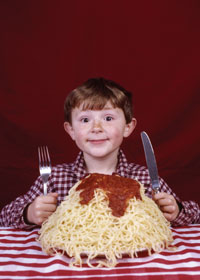 Got a “pastafarian” at your house? One who’ll eat Cheerios and little else? Congratulations! You’re parenting a picky eater.
Got a “pastafarian” at your house? One who’ll eat Cheerios and little else? Congratulations! You’re parenting a picky eater.
Actually, kids at this age are notoriously picky eaters. Parents know that this is a critical time for developing healthy eating habits. But many feel overwhelmed by the daily struggle to get a toddler to make good food choices.
We asked the experts for 10 tips to get your tot on track at the table.
1. Make it a party.
Natalie Kryger is a Snoqualmie area mom who home-schools her four boys, ages 1 to 10. She noticed her boys’ enchantment with a “party platter” of fruit at her local grocery store, so she bought a ceramic “chips and dip” type set and starting putting out cut fruit while her boys did their school work. Fruit consumption is way up at Kryger’s house, now that she has made snack time a party.
2. Present, present, present — and be patient.
Mary Jones, M.S., R.D., C.D., is a pediatric dietitian for Seattle Children’s Hospital. She cautions, “Do not force, beg or coax” children to eat certain foods, and says parents should continue to offer a variety of foods. “It may take 25 or more times of a child seeing something on their plate before trying a bite,” she says. That’s right — she said “25 times”! You can help by being a role model at the table.
3. Kids will eat what they’ve watched grow.
Kelly Morrow, M.S., R.D., is a faculty member in the School of Nutrition and Exercise Science at Bastyr University and Nutrition Clinic, and the coordinator at Bastyr Center for Natural Health. She urges parents to get their toddler involved with the family garden and/or buy food locally at farm co-ops, where toddlers can see how food is grown and harvested. A list of local farm co-ops can be found at King County’s Puget Sound Fresh.
4. Get cooking together.
“Even a toddler or preschooler can help in the kitchen,” says Jones. “This allows them to be a part of the process, and may increase acceptance of whatever he or she was involved with cooking. For example, if you’re making spaghetti and meatballs, let the child mush up the meat. If there is a mixed food dish such as a casserole or salad, let him/her mix up the ingredients before getting near hot temperatures.”
5. Offer a dip.
Little kids love to dip! Jones suggests: “Make a sauce or dip that they enjoy and let them try the new food in the dip. Be sure to make foods easy to chew; cut foods into smaller pieces.”
6. Choose organic when you can for safer, tastier food.
According to Morrow, numerous studies show that organic food is safer, especially for babies and children. Buying locally and seasonally can help reduce your costs for organic food. A list of food that is best purchased organically whenever possible and tips on how to save money while shopping for organic is available at Consumer Reports Greener Choices.
7. Try a new fruit or veggie for a snack.
This gets back to variety, which is a cornerstone of good nutrition. A tip for those living near a PCC Natural Market: Your child can try a new fruit or veggie every time they visit a PCC — for free. PCC’s Kid Picks program allows kids 12 and younger to sample, and flags parents to “kid approved” products. Your preschooler can also pick a snack, and the produce staff will wash and cut it for you.
8. Don’t let them tank up on beverages.
Many preschoolers fill up with a lot of beverages — especially juice. “In order to increase acceptance of solid foods at the table, limit milk (cow or soy/rice) to three cups per day and juice to a half-cup per day,” suggests Jones. “More than this amount of calorically dense beverage may fill them up too much before the meal.” Kelly Morrow also suggests that parents avoid offering lots of juice between meals.
9. Limit fast food.
Morrow points out that relying on fast food is clearly not a healthy eating habit. Fast-food restaurants are very savvy about developing “brand loyalty” early in tiny customers — thus the meal-with-a-toy concept and the barrage of commercials for fast food during children’s television programming. Avoid fast food by having a cooler in the car with healthy snacks and beverages.
10. Get help if you need it.
Mary Jones says that if you and your family physician decide you need help getting your child’s eating habits on the right track, look for a registered dietitian or certified nutritionist, ideally someone skilled in pediatrics and behavior change.
Kathleen F. Miller’s daughter and son have a backyard garden and enjoy visiting the Root Connection Farm in Woodinville, followed by ice cream at nearby Thenos Dairy.
Resources
Jones recommends the following books for parents:
How to Get Your Kid to Eat ... But Not Too Much by Ellyn Satter, RD, ACSW
Secrets of Feeding a Healthy Family by Ellyn Satter, RD, ACSW
Real Food for Healthy Kids: 200+ easy, wholesome recipes by Tracey Seaman and Tanya Wenman Steel
Feeding the Whole Family by Cynthia Lair











